Motions Of The Earth – Worksheet To Enhance Students Skills And Knowledge With Fun
Motions of the Earth – worksheet is mainly designed for the students of class VI. Here, we have used very simple language so that even the slow learners can understand easily. Motions of the Earth – worksheet covers the entire chapter of Geography. This worksheet can be solved individually or in a small group. The teachers can take the printout of this worksheet and can distribute it among the students. Hope that it will not only enhance students’ skills and knowledge but also reduce the burden on social science teachers. Images and picture-based questions from Motions of the Earth will make learning fun and interesting.
If you are looking for the Lesson Plan of Motions of the earth, click on the link.
Class VI Social Studies Lesson Plan For The Month Of August – September With Activities
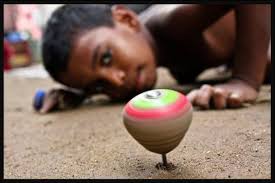
Indian way of learning Rotation of the Earth.
Motions Of The Earth – Worksheet
1. Do you agree or disagree with the following statements:
i. Axis of the earth is an imaginary line about which the earth rotates.
ii. Earth takes exactly 365 days to revolve around the sun.
iii. Day and Night on the Earth occurs due to rotation of the Earth.
iv. On 21st march, the Tropic of Capricorn receives direct rays of the sun as the South Pole tilts towards it.
v. Every fourth year, February is of 29 days instead of 28 days.
vi. When there is spring in the Northern Hemisphere then there is summer in the Southern Hemisphere.
Q2. Fill in the blanks with the correct answer from the given box.
autumn, Southern, 24 Hours, day, Sun,21st June. Earth day, night, 66½, spring |
i. The earth receives light from the ________________
ii. The earth takes about ______ to complete one rotation around its axis.
iii. The period of rotation is known as the _________
iv. On 23rd September, it is ______ season in the Northern Hemisphere and ___________ season in the Southern Hemisphere.
v. The portion facing the sun experiences ______ while the other half away from the sun experiences ____________.
vi. The axis of the earth makes an angle of ________ degree with its orbital plane.
vii. Australia lies in _________ Hemisphere.
viii. The longest day and the shortest night at these places occur on ___________
Q3, Give One word for the following:
i) Two types of motions of the earth.
II) Movement of the earth on its axis
III) The movement of the earth around the sun in a fixed path or orbit
IV) The circle that divides the day from night on the globe
V) An ancient Indian Astronomer who stated that the earth is round and rotates on it’s own axis.
VI) A year with 366 days.
VII) The longest day in the Northern Hemisphere.
VIII) Earth experiences equal days and equal nights.
IX) Smallest day in the southern hemisphere.
X) Americans (U.S.A.) celebrate Christmas in this season.
Motions Of The Earth – Worksheet
Q4. Image Based Questions:
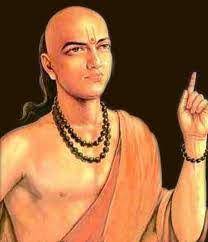
IDENTIFY THE FAMOUS PERSONALITY?
- Identify the famous Indian Astrologer and Mathematician from Ancient India?
a) Aryabhatt
b) Chanakya
c) A.P.J. Abdul Kalam
d) Tulsidas
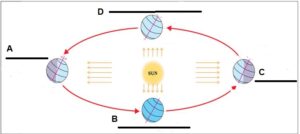
2. Select the correct sequence from the options given
A B C D
- 21st June 23rd March 22nd December 23rd September
- 22nd December 23rd March 21st June 23rd September
- 21st June 23rd September 22nd December 23rd March
- 23rd March 23rd September 21st June 22nd December

3. Look at the image. The earth also moves at a point. This type of movement of earth on it’s own axis is called___________?
a) Rotation
b) Revolution
c) Equinox
d) Summer Solstice
If you are looking for the Lesson Plan of Motions of the earth, click on the link.
Q5. Paragraph-Based Questions:
A. Read the given paragraph carefully and answer the following questions:
The earth has two types of motions. It receives light from the sun but due to the spherical shape of the earth, only half part of it gets light from the sun at a time. The portion facing the sun experiences day while the other half away from the sun experiences night.
It takes 365¼ days (one year) to revolve around the sun. We consider a year as consisting of 365 days only and ignore six hours for the sake of convenience. Six hours saved every year are added to make one day (24 hours) over a span of four years.
Q1. What are the two types of motions of the earth?
Q2. Why does the earth’s only half part get light from the sun at a time?
Q3. One extra day in case of a leap year is added in which month of the year?
Q4. Why is there a Leap Year every four years?
Q5. When will be the next Leap Year ?
B. Read the given paragraph carefully and answer the given questions:
The Northern Hemisphere is tilted towards the sun. The rays of the sun fall directly on the Tropic of Cancer. As a result, these areas receive more heat. The
areas near the poles receive less heat as the rays of the sun are slanting. The North Pole is inclined towards the sun and the places beyond the Arctic Circle
experience continuous daylight for about six months. The longest day and the shortest night at these places occur on 21st June. At this time in the Southern Hemisphere all these conditions are reversed. This position of the earth is called the Summer Solstice.
The reverse happens in the Southern Hemisphere.
21st March and 23rd September , direct rays of the sun fall on the equator. At this position, neither of the poles is tilted towards the sun; so, the whole earth
experiences equal days and equal nights. This is called an equinox.
Q1. When do we have the longest day and shortest night in the Northern Hemisphere?
Q2. During which season the Australians celebrate Christmas?
Q3. When do we have the longest day and shortest night in the Southern Hemisphere?
Q4. What is Summer Solstice ?
Q5. What is Equinox?
If you are looking for the Lesson Plan of Motions of the earth, click on the link.
You may find the following links useful.
Class VI Social Science Lesson Plan For The Month Of April-May – Activity Based
and Class VI Social Studies Lesson Plan For The Month Of August – September With Activities
Motions Of The Earth – Worksheet
Conclusion:
Motions of the earth worksheet is designed as per the CBSE Board pattern. As you know that CBSE has introduced MCQs, Objective questions, Picture based questions, and very short answer-type questions to check the understanding of the students. This worksheet on Motions of the earth also contains similar questions that children will love to solve. The main purpose to make the students solve this worksheet on Motions of the earth is to understand Rotation, Revolution, Leap Year, Summer, and Winter Solstice.
Was this worksheet helpful to you? We are now working on the next worksheet of the History and Civics chapters. If you want to get notifications about the next worksheet, then subscribe through your mail id.
Are you also teaching in classes VII and VIII? The following links will be helpful to you in designing and planning your lessons. Just have a look.
13 Points you Must Include In Your Class VII Social Science Lesson Plan
Class VIII Lesson Plan Of Social Science – Why Is It So Famous?

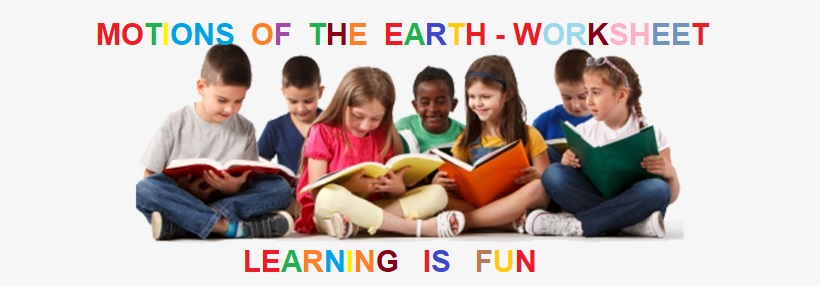


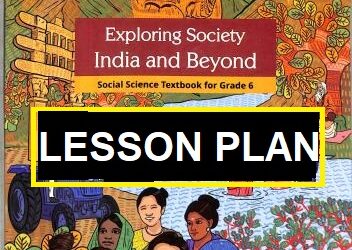
0 Comments